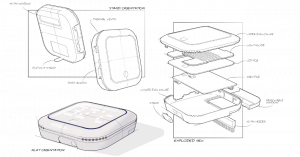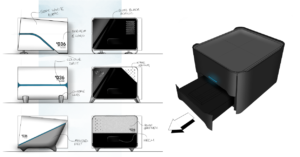In the dynamic world of product design, the art of conceptual design is the first step and is the driving force behind innovation and successful products. This pivotal phase isn't just a box to tick off; it's a creative playground where ideas are nurtured, possibilities explored, and the trajectory of your product's journey is charted.
Here, we'll discuss why conceptual design isn't just important, that it's essential for making products that really resonate with their users.
At its core, conceptual design is about envisioning possibilities and laying down the tracks that guide the entire product development journey. It's the time when designers roll up their sleeves and explore ideas for the project using a variety of tools including drawings, physical models and 3d renderings of basic, preliminary ideas. They usually ignore technical information such as dimensions, so that they can be reviewed and modified quickly and easily.
But why is this phase so significant?
Imagine that you're about to embark on a cross-country road trip without a map or GPS. Well, conceptual design will provide that much-needed roadmap. It's the first benefit to conceptual design, as it always provides clarity of what a product can do and what its intended use is. Without a solid understanding of the product's purpose and intended use, hurdles and confusion may emerge down the line.
Effective conceptual design isn't just about the way it looks. It's about creating a user interface that's intuitive and user-friendly. By focusing on user-centric design principles, you're not only making the product easier to use, but also connecting with your target audience to show them you understand what they're looking for.
Consumers will find your product more appealing when it meets their needs seamlessly.
Conceptual design isn't a solitary sprint—it's a relay race involving engineers, designers, and stakeholders. This phase looks at the roles of different users and their unique requirements. The detail from this guides the subsequent design stages to ensure everyone is on the same page and working towards the same vision from the outset.
While trends come and go, the innovative spirit remains eternal. Conceptual design is the playground where innovation takes its first steps. By carefully considering the perspective of the user and aligning it with current design trends, you're going to be making a product that not only meets today's needs, but also lasts.
Here's a striking statistic: around 75% of manufacturing costs for a typical product are determined during the conceptual design phase.
This makes conceptual design so vital, as the decisions you make here, reverberate throughout the product's lifecycle. By nailing down essential aspects early, you're preventing resource-draining changes in later stages of the project, making it a smoother and more cost-effective development journey.

So, what's under the hood of conceptual design? What elements come together to create this crucial phase?
Conceptual design is all about generating a multitude of ideas and refining them through iteration. It's a dynamic process where initial concepts evolve, merge, and transform.
Gone are the days of the lone genius designer toiling in isolation. Conceptual design flourishes when you work together and collaborate. Engineers, designers, and stakeholders gather to pool their expertise, visions, and insights. This diversity can fuel creativity for a well-rounded outcome. But beware that it can cause issues if there are too many cooks in the kitchen.
Design thinking is the heartbeat of conceptual design. It involves putting yourself in the users shoes, to empathise with their needs and design solutions that genuinely enhance their experiences. This approach drives innovation that resonates with real people.
While honouring current design trends is crucial, it's equally vital to anticipate what lies ahead in the future. Incorporating emerging trends into your conceptual design, means that your product may stay more relevant and appealing for longer.
Imagine a symphony without a conductor. Communication orchestrates the conceptual design phase. Clear communication ensures that the voice of every member of the team is heard, meaning everyone is on the same page and the design aligns everyone's efforts.
If you want to know more, 4D co-founder Iain McCall detailed his thoughts about what concept design is.
The terms "conceptual design" and "product design" often intertwine, but they play distinct roles.
Conceptual Design: This early-phase creative process explores ideas, hones concepts, and sets the product's direction. It's the seed from which the full-fledged product design grows.
Product Design: This encompasses the entire product development journey—taking the refined concept and turning it into a tangible, functional, and aesthetically pleasing product.
In the grand tapestry of product creation, conceptual design is the brushstroke that lays down the initial colours, shapes, and textures. Its significance flows through the design journey, ultimately shaping the very essence of the final product.

Iteration is the secret that elevates good ideas to extraordinary solutions. Embracing this means you acknowledge your first idea might not be the best. It's a stepping stone to refining and enhancing your concept. This process isn't linear. It's a looping dance of revisiting, reimagining, and refining until your concept is how you want it to be.
As with any creative effort, conceptual design isn't without its challenges. The art lies in navigating these hurdles with finesse.
There's so many thing you could potentially look at here. But here's what our experts at 4D Products think:
Designing Sustainably and Ethically - The environmental consciousness of our era calls for designs that prioritise sustainability. Conceptual design will increasingly weave ethical considerations into the fabric of product creation.
Integration of Emerging Technologies - Emerging technologies like artificial intelligence and augmented reality are already starting revolutionise the way we design a product. Conceptual design will tap into these technologies making the potential output limitless.
Enhanced Collaboration Tools - In an interconnected world, collaboration tools will evolve to facilitate seamless communication and brainstorming, making cross-border design collaborations the norm.
Inclusivity and Diversity - Conceptual design will thrive on a diverse pool of talents, embracing voices from various backgrounds, cultures, and perspectives.
As technology advances and user expectations evolve, the role of conceptual design will always be essential. The principles of user-centric, innovation, and collaboration will continue to drive product design. By embracing these principles and securing your product's foundation in a robust conceptual design phase, you're not just creating products, you're shaping experiences.

In the grand tapestry of product creation, conceptual design is the thread that stitches creativity, innovation, and practicality into a harmonious whole. It's the inception point where ideas are born, nurtured, and transformed into tangible wonders. From bridging the gap between users and designers to steering the course of innovation, conceptual design plays an integral role.
As you venture into the world of product innovation, remember the essence of conceptual design. It's not just a stage in a project. It's a mindset. A vision to reshape the world through thoughtful design. So, embrace the power of conceptual design, and let your imagination fuel your innovation so it can leave a lasting impact.
So, the next time you embark on a product design adventure, remember that the magic begins with conceptual design.
[wp-faq-schema accordion=1]